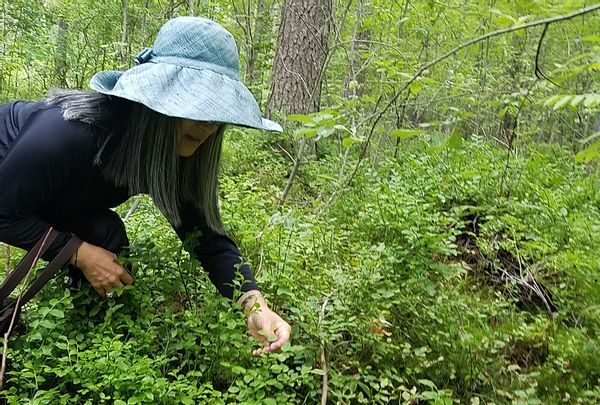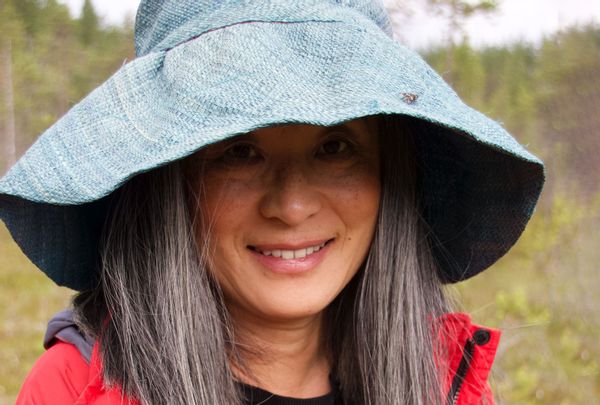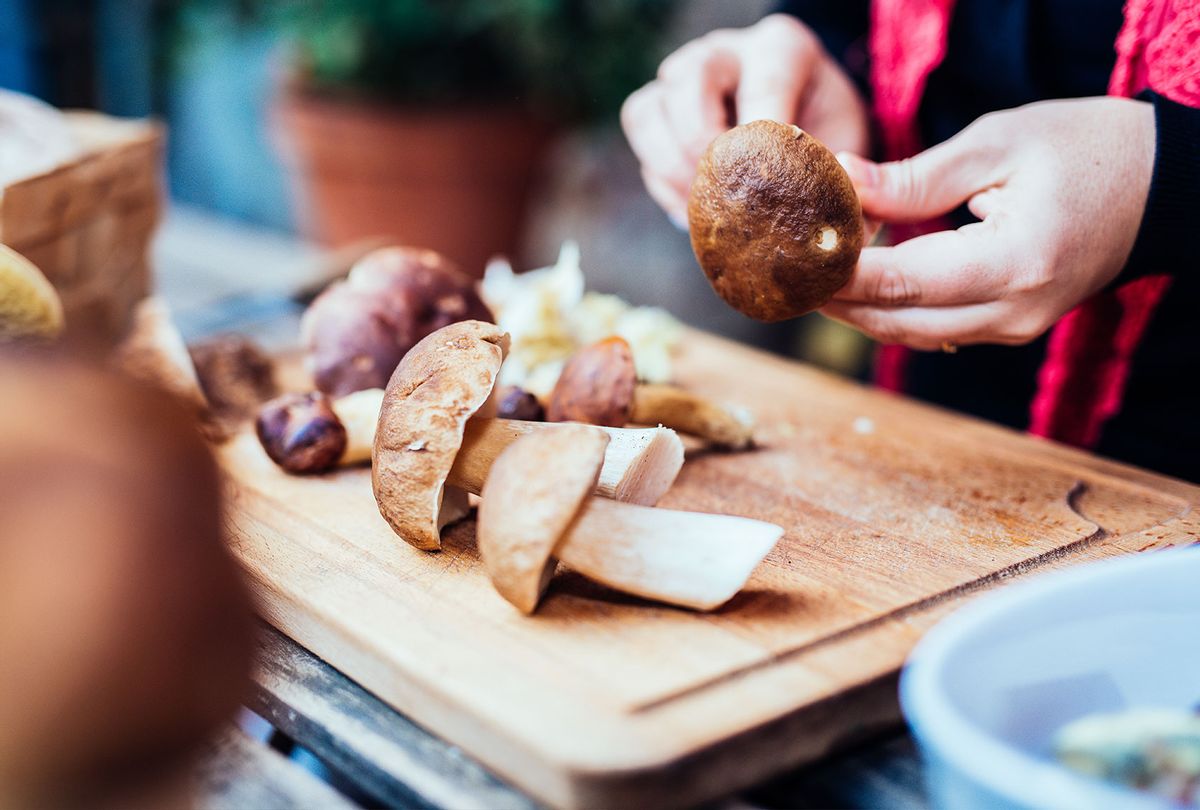"Go on, pick it," said Päivi the Mushroom Queen. "I'm afraid," I mumbled.
She pointed to a prominent-looking mushroom standing exposed all by itself on the pine needle- and twig-laden ground. It had a saucer-like brown cap two inches in diameter and a sturdy beige stem.
The mushroom looked so picture-perfect that I thought I might accidentally mutilate it while trying to separate it from Mother Earth.
I was wandering in a dense forest with master mushroom forager Päivi and a group of several other Marthas. My boots squished on an uneven, cushiony carpet of moss and fallen leaves, giving my knees, legs, and back a tender workout.
An hour earlier, before we set off on our hike, Päivi opened her car trunk in the parking lot and produced a supply of homemade mushroom cookies and a Thermos full of delightfully mellow, nutty-vanilla-tasting chaga mushroom tea to enjoy. Chaga mushrooms (Inonotus obliquus) appear as charcoal-black clusters on the side of birch trees, with a golden brown interior, and for centuries they've been used in traditional medicine in Finland, Russia, and elsewhere. Today, chaga can be enjoyed as a tea or as a powder or liquid to add to soups or smoothies, and researchers are finding that there may indeed be health benefits from the mushroom, including antioxidant, anticancer, antiviral, anti-inflammatory and pro-immune system effects.
RELATED: The pesky mushroom cookies I bake for Betsy, my late mother-in-law
Fortified by tea-and-cookie mushroom power, we set off into the woods. There was no path and no trace of civilization, only birch, pine, and spruce trees rolling over gentle hills in all directions. My eyes scanned around a magical landscape of lush, expansive vegetation, layers of bright green moss- and whitish-gray reindeer lichen-covered rocks, one-foot-tall miniature trees, fallen branches, twigs and leaves, ferns, low berry bushes, wildflowers and grasses, an anthill, white birch trunks, stately dark brown pine trunks soaring into the sky, and some fallen trunks leaning on top of each other. Glittering light streamed through leaves, branches, and tree trunks, casting diagonal streaks and shadows in the forest.
I inhaled rich vapors of moist pine, heard hushed conversations of wispy wind and birch leaves, and sensed my breathing synchronized with natures' pulses. My physical, emotional, and spiritual beings were completely blending with the sur- roundings. The most profound sensation of bliss filled my body and soul, a mystical sensation that I had never known existed or was possible.
After spending some time in the forests of Karelia, I came to realize that fairy tales I had read when I was a child were not quite fairy tales, but somehow real. As one visitor from Sydney, Australia, a woman named Ali Noble, explained, "Stepping into a Finnish forest is something akin to being in a childhood fairytale: lush, soft lichen underfoot; big red toadstools; tall green trees; and the suspicion that if a fairy did appear, you wouldn't be too surprised." If I came across a group of fairies in this thick enchanted forest, I certainly would not have been surprised at all. I would have understood. Even if I could not see them, they were there, watching over us.
You never forget spotting your first mushroom in a Finnish forest. At least I never will. Sometimes they appear in great congregations on a sloping hillside; other times they poke up flamboyantly as psychedelic-colored exhibitionists from the base of a tree; or as solitary, stately monuments, like this one.
I kneeled down to examine the mushroom spotted by Päivi the Mushroom Queen. This was a trophy mushroom, a porcini (Boletus edulis), a type especially cherished in Italy for its aroma, dense texture, and earthy-rich flavor. Like most mushrooms, this was an engineering marvel, conferring great dignity to the word fungus, which describes all mushrooms. It was barely three inches tall, and it was magnificent. The porcini stood there as if to say, "I am here!" I could only stare at its beauty and stature.
It had such a gorgeous shape and regal, commanding presence — a perfect sculpture by Mother Nature — that I was afraid to touch the mushroom, let alone remove it from the earth.
Päivi kindly said, "I will show you."

Naomi picking berries in Joensuu (William Doyle)
With her guidance, I pushed my fingers into the ground, reaching the bottom of the stem, and gently pulled it out. I shaved the soiled area around the bottom with a brush-tipped mushroom knife, being mindful not to take any more flesh than I needed to. I sliced it vertically in halves and examined the specimen. Clean, white interiors. No worms or bite marks. What a beauty! I placed the halves in the basket like laying down a newborn baby in a bassinet.
We walked deeper into the forest toward a hill. There was no path, just random zigzag patches of clearer ground amid the rocks and fallen branches. Päivi pointed to a mushroom a few feet away. I marveled at how she could see it camouflaged in the environment. Different mushrooms, she explained, prefer the company of different trees: orange- and yellow-colored chanterelles (Cantharellus), for example, like birch forests, while Boletus mushrooms like spruce and pine forests. She approached and picked the small reddish-brown mushroom, which had a one-inch-diameter cap.
She neatly sliced off the bottom of the soil-covered stem with a mushroom knife, dropped the tip, and brushed off dirt and plant specks from the cap with the brush attached to the other end of the knife handle. She closely examined the mushroom and announced, "This is a curry milk cap (Lactarius camphoratus)." She slit the gills. White liquid dotted the incision.
"See, milk," Päivi said. I knew about this treasured mushroom. Another Finnish friend, Anu, a food writer and stylist, recipe developer and chef in Helsinki, had told me how a tiny amount of dried little bits of this mushroom could add an amazing curry aroma to a dish.
Päivi placed the mushroom in her basket. I noticed more on the ground. I picked up one and asked, "Is this a curry milk cap, too?" Päivi said, "Yes." Hooray! Now I could guess a small percentage of what I found! The number one golden rule of foragers is pick and eat only what you can identify 100% for sure, or you may be poisoned. Which is why I didn't plan on foraging alone.
Päivi stopped and picked up a medium-sized green-grayish mushroom with corrugated edges around the cap.
"This is good," she said. "This is a hapero (russula, Russula)." She cleaned it and put it into the basket. I thought to myself, I never would have guessed that this would be a good mushroom, because the colors looked moldy. Sorry, hapero!
Want more great food writing and recipes? Subscribe to "The Bite," Salon Food's newsletter.
Päivi moved briskly through the forest focusing on spotting "good" mushrooms. I picked two promising mushrooms, caught up with her, and asked, "How about these?" She glanced and quickly said, "No. Not good." I tossed them to the ground. Päivi added, "They're not poisonous. But they're not good. We don't eat it."
She picked another mushroom, "This is a milk cap." I asked, "A regular one?" "Yes." She cleaned it and put it into a small paper bag in the basket. She was separating them from others, as she'd first boil them in water for ten minutes to rid them of their tartness.
I found more curry milk caps hidden under ferns and leaves around mossy rocks. I showed them to Päivi and she nodded. I cleaned them and placed them in the basket. I felt proud that I was getting good at it, though I still needed an expert to verify. I picked a mushroom and asked, "Is this a milk cap?" Päivi, "Yes, but it's not a good one." She added, "It's so small." I repeated, "It's small . . . OK," I tossed it, puzzled.
For some mushrooms, like chanterelles, small was good because they were packed with flavor. I picked two mushrooms and asked, "These are no good, right?" Päivi perked up. "Not this one, but this one is very good!" pointing to a very dark brown mushroom. "It's a nokirousku (chocolate milk mushroom, Lactarius lignyotus)!" she said excitedly. A small, three-quarter-inch diameter, very dark-brown cap with white gills and a long, skinny dark-brown stem. I saw more of the same. I picked them, and asked, "Are they good?" "Yes," she said. "This one, too?" I asked. Päivi said, "Yes. Yes, these are very good. They're milk caps but they can go directly into a pan." There was no need to boil them like regular milk caps. I mumbled to myself, "You never know which ones are good."
She took a few steps, bent down and picked another. "This is also a hapero." She sliced off the bottom of its stem, and looking at the cut section of the stem, said, "A very good one. See, no worms." She sliced the stem and the cap vertically in exact halves. Yes, I saw that it was a clean, beautiful mushroom. "You're going to eat this," she said, smiling.
Päivi said, "This one is a haaparousku (northern milk cap, Lactarius trivialis)," holding up a grayish-purple cap mushroom about two inches in diameter. It was quite exotic and beautiful. She added, "You need to cook this one for five minutes to reduce its tartness."
Päivi picked a reddish cap mushroom, cleaned the stem, peeled the thin red skin, cut a small piece of white flesh, and handed it to me. She sliced another piece and put it into her mouth. I put mine into my mouth, tasted it, and immediately spat it out. "It's so peppery!" We both laughed.

Naomi Moriyama (Riikka Simonen)
We soon found small and medium-size chanterelles (Cantharellus cibarius), another prized treasure from the forest. Päivi disappeared into the woods and came out with creamy white mushrooms with warped caps. She said, "They are vaaleaorakas (wood hedgehog or hedgehog mushroom, Hydnum repandum)! I was looking for these!" happily announcing her feat.
With our baskets filled with treasures from the forest, we headed to Sovintola, a handicraft and culture center that included a full rustic kitchen that we could use. First, we sorted the foraged mushrooms on a large table on an outdoor terrace. Päivi took us through the characteristics of each variety.
She brought them into the kitchen and proceeded to slice and sauté several varieties of mushrooms with butter in a frying pan. "This is the best way," she told me as I looked over her shoulder. The aromas of heated butter and mushrooms filled the kitchen, my nostrils, and my month. The mushroom flesh was getting golden brown, and the edges crusty. She flipped each slice expertly with two forks making sure not to overcook. Then it was lunchtime.
First, we sampled the pan-sautéed mushrooms we picked only two hours ago. My heart pitter-pattering, I pierced a piece with a fork and brought it carefully into my mouth. I contemplated its flavors, textures, aromas, and all the nuances in between. I tasted the earth, raindrops, dried pine needles, mosses, and above all, Mother Nature's love. Everyone was quiet. We didn't have to say anything.
Päivi, the forager-chef, then served porcini-cream soup garnished with dried slices of porcini. Fantastic. Next, she served toasted rye bread topped with spruce-tip pesto, followed by blocks of bread cheese (or Finnish "squeaky cheese" in the United States) with yellowfoot (Craterellus tubaeformis) jam, which might sound strange but is totally delicious. For dessert, she brought out lingonberry-carrot Karelian pies and yellowfoot mushroom cookies, which were a perfect way to conclude our mushroom feast — all homemade, except the cheese.
While much of the world was relying on overprocessed, over industrialized food, here in North Karelia, the Marthas were upholding the great Finnish tradition of a wilderness-to-table food lifestyle, nurtured by their everyday relationships with nature.
We stared at the rich gifts from nature with gratitude and pride.
It was the "wildest" meal of my life.
As a farewell gift, Päivi gave me a bottle of homemade chaga elixir, which she instructed me to take a small spoonful of daily.
If you liked this essay, consider buying "The Sisterhood of the Enchanted Forest: Sustenance, Wisdom, and Awakening in Finland's Karelia" by Naomi Moriyama and William Doyle.
Read more:

Shares